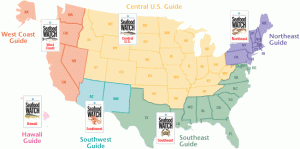Socially responsible fish!
So, it is the end of a long day on the beach and now you want some seafood. Completely understandable. And, I applaud this question and the quest to be socially responsible. Your choices will make a difference.
It is a tough question to always have a correct up-to-date answer, especially since it varies for regions.
What I can do is recommend a fantastic site that always provides these up-to-date answer – and – for each region. The Monterey Bay Aquarium will even provide you with a seafood pocket guide that you can fit in your wallet.
The guide is broken down into best choices, good alternatives, and fish you should avoid. These valuations are based on fisheries (or fish farms) that are healthier for long term sustainability of the oceans and apart from what one can catch from shore fishing.
Currently, the best farmed choices for the northeast US are char, barracmundi, catfish, oysters, mussels , clams, bay scallops, strugeon (cavier), tilapia, and rainbow trout. The best wild choices for the northeast US are clams, dungeness crabs, atlantic croacker, spiny lobster, pollock, salmon, longfin squid, swordfish, albacore (troll/pole caught) and skipjack tuna (troll/pole caught).
Species labeled as avoidable according to the Monterey Bay Aquarium’s Seafood Watch are: chilean seabass, atlantic cod, imported king crab, Atlantic dogfish, sole, haddock, white hake, imported mahi mahi, marlin, monkfish, orange roughy, farmed salmon, shark, skates, imported or wild shrimp, red snapper, imported wild strugeon (cavier), imported swordfish, tilefish, albacore, bigeye, yellowfin tunas (caught on longline), bluefin tuna, and farmed yellowtail.
Whew.

Don’t forget to download the guide according to your region.
Do you have another great question? Check out www.beachchairscientist.com and let us know what you always ponder while digging your toes in the sand!









What people are saying …